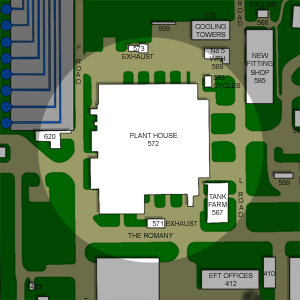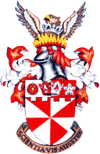 |
The Buildings
home | the buildings | plant house (572)

Plant House (572)
Built: 1951
Decommissioned: 2002
The original northwest corner of the new Pyestock site was occupied by the
Plant House. It shared little architectural similarities with the other buildings
erected at Pyestock, being built mostly of brick. This gave the Plant House
its unique appearance as a huge, squat blockhouse brooding in the corner of the site surrounded by the blued-painted,
steel-cladded, multi-windowed buildings which characterised the rest of Pyestock.
Its design mirrored the Compressor House of the old Pyestock site.
In this building a hall housed the necessary plant for air supplies and down one side of the building individual
cubicles contained test rigs where experiments were performed on individual components or
scaled-down gas turbines. The Plant House was a scaled up, symmetrical version of this
building with a centralised plant hall, two valve bays either side, and rows of cubicles on either
side of those.
The Plant House was initially intended for combustion and aerodynamic experimentation
and its solid brick construction reflected the requirements for a sturdy building in which to carry
out these tests, and one which could contain any mishap.

|
The eastern side of the Plant House
showing the offices.
03|03|07 © Simon Cornwell 2007
|
By 1954, the Plant House had taken shape in the emerging new site. The original plan
called for a plant hall housing nine separate machines, but this proved too expensive (and would’ve
been a match in size and capacity for the future Air House).
Ideas were rationalised and the use of compressor/exhauster plant allowed the number of large machines
to be whittled down to three: two Metropolitan-Vickers axial-flow compressor/exhauster sets and
a Parsons air-bleed gas turbine. These supplied air to the pressure and suction mains controlled
via a control room at the end of the hall.

|
|
Figure 1: Diagram Of Plant Hall Cubicles And Cubicle Exhausts
|
Pressure and suction mains from these machines were routed to the two valve bays, either side of
the plant hall. These allowed custom connections and piping to be constructed between the mains
and the test rigs located in the adjoining cubicles. The pressure and suction mains were
also routed outside the building, allowing other test rigs
(such as Cell 1 & 2 and the
14000 HP Turbine) to be connected to a source of air.

|
Elevated view east along the plant hall.
03|03|07 © Simon Cornwell 2007
|
The cubicles were large empty, two-storey spaces. Exterior doors and an overhead gantry crane
allowed test equipment to be winched in, whilst a viewing room set high in the first storey
allowed the scientists to view and control the experiments in relative safety. Five cubicles
for combustion testing were built along the north side of the building, whilst four aero
testing cubicles occupied the southern side. One of the aero cubicles, so named Aero Catherdral,
was double the size of the other cubicles, obviously intended for far larger testing equipment.

|
View west across Cubicle C5.
21|04|07 © Simon Cornwell 2007
|
The initial designers realised the Plant House had limits and designed the building with expansion
in mind. The western end was a blank wall, and tentative future plans allowed the building to expand
westwards, adding new cubicles and plant as necessary. However, Pyestock expanded in a
very different way and the requirements for supersonic, full scale testing necessitated the building of
entirely new air supplies and testing cells. (The eventual Air House
and it associated supersonic cells).
Even with the new supersonic, full sized test cells, component testing was still required, and the
Plant House enjoyed a long functional life at Pyestock. Whilst some of the cubicles
were empty and had been obviously mothballed, and others were used as storage areas, a few were still packed
with test equipment and reports, suggesting the Plant House was in use right up until the site closed.
Plant House Walkthrough...
|


